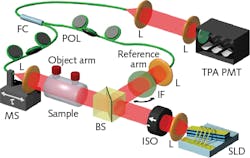Novel Spectroscopy: Superluminescent diode enables first thermal-light ‘ghost spectroscopy’ demonstration
Ghost imaging (GI) is a spatial imaging modality exploiting photon correlations either on a quantum basis with entangled photons or with classical thermal photons exhibiting photon bunching. One of these correlated beams illuminates the object and is detected without any spatial information, whereas the second, the so-called reference beam, is spatially analyzed by scanning it. However, this beam has never seen the object. Thus, each of the two beams alone does not contain any image information. However, the correlation of both beams surprisingly yields the image—therefore, the name “ghost image” has been termed.
Originally demonstrated for the first time in 1995 with entangled photon pairs from a parametric down-conversion source, the GI phenomenon was shown in 2002 with classical thermal light followed by numerous experiments exploiting classical thermal correlations, thus proving that GI cannot be considered as a quantum effect only. There, mostly pseudo-thermal light sources were used based on coherent laser light in combination with a speckle-generating diffusive element and, less often, spectrally filtered incandescent lamps.
Broadband, high-spectral-resolution requirements
Researchers at Technische Universität Darmstadt in Germany have succeeded in transferring this concept of classical spatial correlations of GI into the spectral wavelength domain, thus performing the first ghost spectroscopy (GS) experiment with classical thermal photons.1 The group exploited spectral wavelength-wavelength correlations of broadband amplified spontaneous emission light emitted by an ultracompact, miniaturized, optoelectronic semiconductor-based quantum dot superluminescent diode (SLD). In the spirit of the Hanbury-Brown & Twiss experiment, this light exhibits a spectral second order correlation coefficient g(2) (l) of two, and thus spectral photon bunching, one of the prerequisites for ghost spectroscopy.
To approve the applicability of this light source concept to ghost spectroscopy with classical light, the Darmstadt group conceived a real-world absorption spectroscopy experiment on liquid chloroform (see figure). A 35 nm broadband highly directional amplified spontaneous emission light beam from an SLD with a central wavelength of 1230 nm and exhibiting the necessary corresponding spectral correlations has been divided by a beamsplitter into a frequency or wavelength-correlated object and reference beam.
The object beam interacts spectrally with the chloroform (CHCl3) absorption sample. However, its transmitted intensity is fully measured and non-spectrally resolved whereas the reference beam (which does not “see” the spectral object at all) is spectrally resolved and detected by a combination of spectrally tunable interference filters. Thus, each of the two beams alone does not contain any spectral information of the sample. However, correlating the intensity of the reference and object arm in the spectral domain yields the second-order correlation coefficient g(2) (λ), now in terms of a reconstructed ghost spectrum that clearly exhibits the characteristic chloroform absorption signature S(λ) at 1214 nm. Therefore, this ghost absorption spectrum is the analogue to a ghost image in the spatial domain.
This work fills a gap of experimental demonstrations of ghost-imaging modalities. Before, no ghost-spectroscopy experiment with classical light had been realized using thermal light sources. One of the reasons for this missing demonstration has been the technical demands of high measurement time resolution τmeas (τmeas << τcoherence) when intensity correlations of spectrally broadband light τcoherence = 1/ Δν are measured. Only by exploiting interferometric two-photon absorption (TPA) detection has it been possible to resolve the ultrashort correlation timescales of the broadband light emitted by the SLD. A secondary challenge lies in the difficulty in finding a practical light source that provides a broadband spectrum, as well as the required wavelength correlations in order to enable the ghost-spectroscopy modality.
The authors expect that the highlights of this innovative scheme in the spirit of the ingredients of ghost spectroscopy with classical thermal light will further stimulate new applications of ghost modalities. They are convinced that the depicted and exploited analogy between ghost imaging and ghost spectroscopy will further fertilize the field, thus allowing the development of an even deeper understanding of the experimental scheme, leading to new ghost protocols and pushing the ghost modality idea in real-world applications in chemistry, physics, and engineering.
REFERENCE
1. P. Janassek et al., Phys. Rev. Appl., 9, 2, 021001 (Feb. 2018).
About the Author

Gail Overton
Senior Editor (2004-2020)
Gail has more than 30 years of engineering, marketing, product management, and editorial experience in the photonics and optical communications industry. Before joining the staff at Laser Focus World in 2004, she held many product management and product marketing roles in the fiber-optics industry, most notably at Hughes (El Segundo, CA), GTE Labs (Waltham, MA), Corning (Corning, NY), Photon Kinetics (Beaverton, OR), and Newport Corporation (Irvine, CA). During her marketing career, Gail published articles in WDM Solutions and Sensors magazine and traveled internationally to conduct product and sales training. Gail received her BS degree in physics, with an emphasis in optics, from San Diego State University in San Diego, CA in May 1986.
